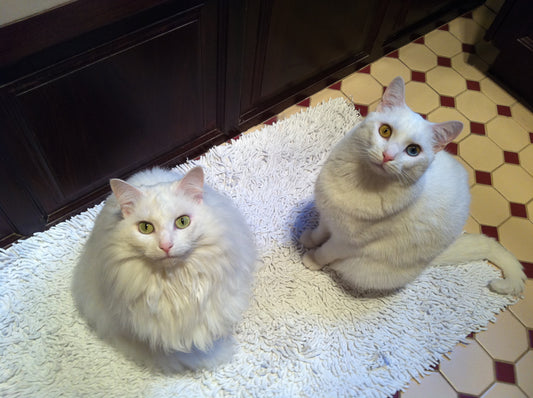Heugh! Yak! Gleugh! That familiar, gross sound of your cat hacking up a hairball. We’ve all heard it. It’s a sound we all dread—an inevitable part of being a cat parent.
But what causes hairballs, what do we do if they get worse, and how can you help reduce them for your cat?
What are cat hairballs
Hairballs are completely natural, and all cats will experience them at some point. As they groom themselves, the backward-facing hooks on their tongues pull out any loose hair, which they then swallow.
Most of this passes naturally through their digestive system, but sometimes it collects in their stomach in a ball before being vomited up. Of course, as it passes back up the oesophagus, it gets squashed into a tube shape. So, when it hits your floor, it might appear more long and tube-shaped than a ball-shape, and it’ll likely look very slimy. Eugh!
Cat fur growth lesson
Your cat’s fur grows in cycles, and although frustrating, shedding fur is a normal part of this cycle. However, the cycle can be influenced by external factors, like environmental changes, stress, age, and health conditions.
There are three stages in the life of a cat’s hair, each lasting different lengths of time.
The anagen phase
This is the active growth phase of the hair. It's the longest phase (although it’s much shorter than in humans). The hair cells are rapidly dividing, and the hair shaft is getting longer.
The Catagen phase
Also known as the transition phase. The growth slows, and the shaft disconnects from the bottom of the hair bulb but remains in place. This phase is usually quite short.
The Telogen phase
The messy one. Initially, the hair remains in the follicle, but new cells are forming to develop the next hair. Eventually, the hair disconnects and is shed. This is helped along by grooming…potentially causing hairballs.
Hair growth is regulated by the interaction between dermal papilla cells and other hair follicle cells. Nourished, healthy skin and follicle cells result in healthier, shiny hair with a longer growth phase.
Why do cats get hairballs?
Hairballs are a normal part of cat life as they are developed when your cat naturally grooms themselves. However, they are more common in long-haired cats and are less likely to be seen in kittens and young cats as they don’t spend as much time grooming themselves.
There are a few things that make hairballs more likely:
- Overgrooming - often caused by stress or arthritis pain
- Allergies - particularly if they are causing skin conditions
- Poor diet - this may make your cat more likely to lose their fur
- Gastrointestinal issues - this can mean hair can’t pass through their digestive system normally.
Are hairballs dangerous for your cat?
Generally, hairballs aren’t dangerous and pose no risk to your cat. They are a normal part of feline life and can be expected around once a week.
However, if a hairball becomes too large in the stomach to pass either up the oesophagus or through the small intestine, it can become an emergency, requiring surgical intervention. However, this is a rare occurrence and is not something that vets have to do very frequently.
Why do cats get more hairballs in the spring?
The temperature in the springtime is warming up, and cats start to shed their “winter” coat. You’re more likely to see more hairballs… because they are grooming more loose fur out.
However, another element to their springtime woes is the potential increase in parasites like fleas, making them itch and groom themselves more.
Add to this seasonal skin allergy caused by things like pollen. This might have an effect on your cat’s skin health, and you might notice more itching, scratching, and potential over-grooming, resulting in more hairballs.
So, supporting your cat’s skin and coat health will help them manage their fur during this more challenging time.
When to see the vet about your cat’s hairballs
If you’ve noticed an unexplained increase in hairballs or any change to your cat’s behaviour, it’s always a good idea to get them checked out at the vet.
They will want to check them for skin conditions, mites, fleas, arthritis, or anything else that might cause an increase in grooming.
Here are a few signs you should get checked by your vet:
- Vomiting or retching - If you notice your cat retching more without bringing up a hairball, or they're vomiting more.
- Lethargy - If they’re not themselves, not as active, or sleeping more than normal
- Constipation - This can be a sign of hairball-related obstructions, among other things
- Bloating - A hard or bloated abdomen can indicate a problem
- Off their food - Refusing to eat can indicate a problem and should always be investigated by your vet.
Ways to reduce hairballs and support your cat to manage hairballs
Hairballs are natural but unpleasant for all concerned, so here are a few things you can do to help reduce hairballs for your cat.
Groom them regularly
This dislodges lots of the loose hair, meaning they don’t swallow it.
Encourage them to drink
Keeping them hydrated helps their digestive system to function properly. You can encourage them to drink more by introducing a cat water fountain or doing something as simple as placing a full glass of water on a window ledge.
Give them a skin and coat supplement
Healthy skin results in a healthy coat, and introducing the right supplement, like Antinol® Plus, will result in a strong skin barrier and healthy coat, with reduced shedding.
Feed them a hairball diet or increase their fibre intake
These diets are designed to keep the digestive tract moving to prevent a build-up of hair.
Antinol® Plus and fur
You may know of Antinol® Plus because of its role in joint health. But did you know it’s also scientifically proven to support skin health? It reduces inflammation if your cat is struggling with a seasonal or other form of skin condition. It also contains a highly potent blend of omega-3 fatty acids, which maintains a strong skin barrier, supporting healthy hair pores to grow a shiny, healthy coat. Antinol® Plus may also increase the length of time your cat’s hairs remain in the “anagen” growth phase, which means reduced shedding.









